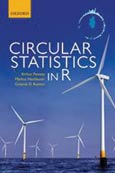Book Reviews 28.1
Circular Statistics in R
Arthur Pewsey, Markus Neuhäuser, and Graeme D. Ruxton

Paperback: 192 Pages
Year: 2014
Publisher: Oxford University Press
ISBN: 9780199671137
In the field of circular statistics, you can’t be picky about your choice of books. Circular Statistics in R, a new book by Arthur Pewsey, Markus Neuhäuser, and Graeme Ruxton, provides only the seventh in-depth treatment of this topic. This new addition aims to be a handbook for applied researchers encountering circular data, which consists of all data of periodical nature, such as angles and directions. This is the first book since 2001 purely focused on circular statistics, so an update of available methods and review of recent innovations was definitely in order.
The first four chapters serve as background reading for newcomers to circular data. Starting with a light introduction, the authors soon move into graphical methods, circular summary statistics, and some distribution theory. These chapters are generally well-written, and though not necessarily exhaustive, they provide one of the better introductions to the subject.
The second half of the book deals with model-fitting, comparison of samples, and circular correlation and regression models. The classic model for circular data is the von Mises distribution, but here the use of more flexible distributions is emphasized—which allows for kurtosis, for example. However, the distinct lack of available methods for employing these more flexible models, even within this book, inhibits their widespread adoption. Applied researchers often have more complex questions than whether their data fits a certain distribution, and they may want more than to assess goodness of fit or parameter estimation. Comparison of samples and regression models get relatively little space in this book, although I assume these are of more interest to researchers.
The book is littered with bits of R code. For those applying circular data analysis in the field, these numerous examples can be a huge boon, especially for those not well-versed in R. The book contains numerous fully written-out functions which present roughly the same tricks applied repeatedly—numerical integration, acceptance-rejection sampling, and boot-strap algorithms. The purpose of these larger chunks of code is a bit beyond me. I assume they are here to help us understand the methods presented. But the code is not particularly well-formatted; indentation and a monospace font would have been much appreciated. And it is not elegantly written; for example, it bypasses—on Page 18—R’s readily available modulus function %% in favor of a clumsy for-loop. There are much better ways the content could have been explained, such as using step-by-step instructions or algorithm pseudo-code.
Regardless, in terms of readability and applicability for basic circular models, there really isn’t a better handbook available, if only for its inclusion of recent work in the field. There are more thorough theoretical introductions, but if you want to apply circular data and are looking for a primer on the status quo, this book is probably your best bet.
About the Author
Kees Mulder graduated cum laude from Utrecht University, where he is currently a PhD candidate in the department of methodology and statistics. His research involves Bayesian analysis of circular data—in particular, issues in employing the von Mises distribution in Markov chain Monte Carlo (MCMC) sampling.

Book Reviews is written by Christian Robert, an author of eight statistical volumes. If you are interested in submitting an article, please contact Robert at xian@ceremade.dauphine.fr.









